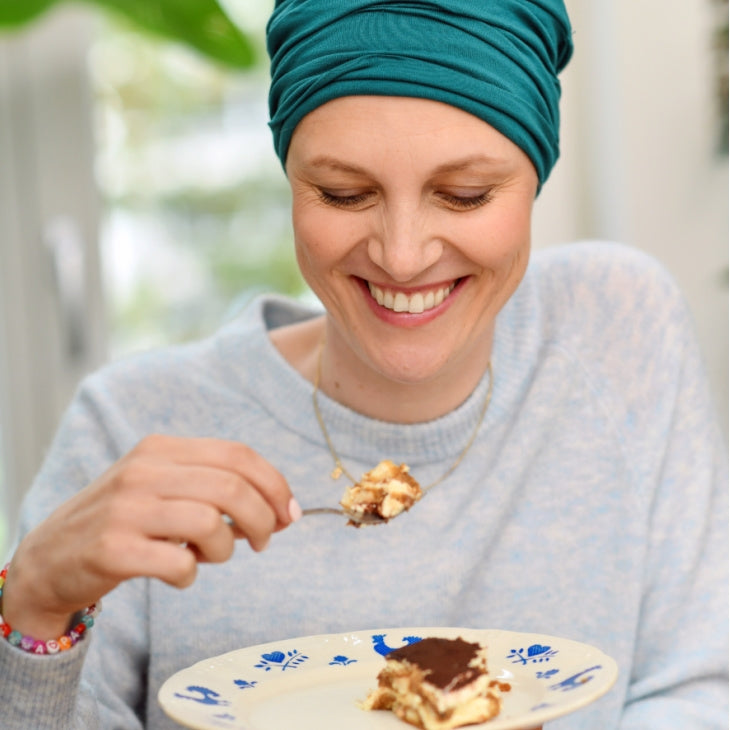Struggling to sleep since you started treatment? Racing thoughts, pain, and even chemotherapy itself can disrupt your rest. These six yoga poses help prepare your body for a good night’s sleep by focusing on your breath and releasing built-up tension. Rule number one: always listen to your body and never force anything.
Before you begin…
- Roll out your yoga mat, slip into a comfy pair of pyjamas, and keep yoga blocks, cushions, or blankets nearby.
- Try doing these poses right before bedtime so you can drift off completely relaxed.
- Hold each pose for three to five minutes—evening yoga is all about slowing down.
- Sync your breath with your movements, inhaling and exhaling through your nose.
- If needed, use cushions or rolled-up blankets for extra support wherever your body asks for it.
 Pose 1: Supta Baddha Konasana
Pose 1: Supta Baddha Konasana
This first pose relieves tension in your hips and deep psoas muscle—common areas where stress builds up:
- Lie on your back, bend your knees, and place your feet on the floor.
- Let your knees fall open to the sides, allowing gravity to do the work.
- Rest your arms alongside your body.
- Place yoga blocks or cushions under your knees for added support.
- You should feel a gentle stretch in your hips and inner thighs.

Pose 2: Uttanasana
This forward fold helps release neck tension while stretching hamstrings, calves, and hips:
- Stand with your feet hip-width apart and bend your knees slightly.
- Inhale, then exhale as you fold your torso forward and down.
- Lengthen your spine as much as possible.
- Hold your elbows, place your hands on the ground, or grab your ankles—whatever feels comfortable.
- Use yoga blocks under your hands if needed.
- Gently nod your head “yes” and “no” to release neck tension.
- When ready, slowly roll back up to standing to avoid dizziness.

Pose 3: Viparita Karani
This restorative pose boosts blood circulation and relieves swollen ankles and feet:
- Place your mat perpendicular to an empty wall.
- Sit sideways next to the wall, then swing your legs up so they rest against it.
- Position your hips as close to the wall as possible.
- Rest your arms alongside your body.
- For extra support, place a cushion or rolled-up blanket under your tailbone.

Pose 4: Supta Matsyendrasana
This gentle twist helps release tension and create a sense of openness:
- Lie on your back with your arms extended out to the sides.
- Bend your knees and place your feet flat on the floor, then shift your hips slightly to the right.
- Bring your right knee toward your chest and stretch your left leg out on the floor.
- Drop your right knee to the left side, letting it rest comfortably on the floor.
- Stretch your right arm wide and turn your head to the right.
- Hold for five to ten breaths, then return to center.
- Rest both legs on the floor for a few breaths, then repeat on the other side.

Pose 5: Balasana (Child’s Pose)
This popular resting pose promotes a sense of stability while relaxing your shoulders:
- Start on your hands and knees.
- Inhale, then exhale as you bring your hips back toward your heels, your torso resting on your thighs, and your forehead on the mat.
- Let your arms rest alongside your body with palms facing up.
- Gently roll your forehead side to side for extra relaxation.

Pose 6: Savasana
This traditional final pose helps your breath return to its natural rhythm:
- Lie on your back and hug your knees to your chest.
- Inhale deeply, exhale, and then stretch your legs out on the floor.
- Position your feet hip-width apart, letting your toes relax and fall outward.
- If you feel tension in your lower back, place a rolled-up blanket under your knees.
- Rest your arms alongside your body with palms facing upward.
- Gently tuck your shoulder blades closer together beneath your chest.
- Stay here for about five minutes, scanning your body and bringing your awareness back whenever your mind starts to wander.
These are our six favourite poses for a restful night’s sleep.
But make it your own: pick the ones that work for you, change up the order, and experiment. Namaste!
Got questions about exercising during or after cancer treatment?
You’ve probably read that staying active after cancer lowers the risk of recurrence—and it also boosts your mental wellbeing. But don’t dive in recklessly. Pace yourself! Listen to your body!
How do you do that when you’re battling fatigue and racing thoughts?
We asked Sarah Soenen, a physiotherapist specialised in oncological rehabilitation, for her expert advice. Read our full interview with Sarah about exercising during and after cancer >>










